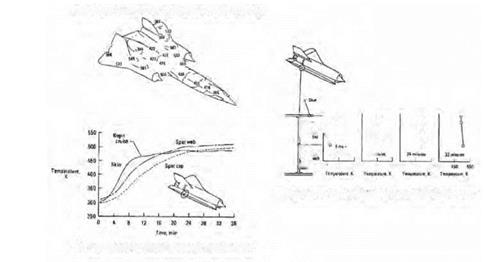YF-12 Thermal Loads and Structural Dynamics
NASA operated two Lockheed YF-12As and one "YF-12C” (actually an early nonstandard SR-71A, although the Air Force at that time could not acknowledge that it was allowing NASA to operate an SR-71) between 1969 and 1979.[936] These aircraft were used for a variety of research projects. In some projects, the YF-12s were the test articles, exploring their performance, handling qualities, and propulsion system characteristics in various baseline or modified configurations and modes of operation. In other projects, the YF-12s were used as "flying wind tunnels” to carry test models and other experiments into the Mach 3+ flight environment. Testing directly related to structural analysis methods and/or loads prediction included a series of thermal-structural load tests from 1969 to 1972 and smaller projects concerning ventral fin loads and structural
(a) Surface temperature distribution (deg K) at cruise
|
||||||||||
|
||||||||||

(b) Time history of typical wing spar temperatures
Temperature time histories from YF12 flight project. NASA.
dynamics.[937] The flight-testing was conducted at Dryden, which was also responsible for project management. Ames, Langley, and Lewis Research Centers were all involved in technical planning, analysis, and supporting research activities, coordinated through NASA Headquarters. The U. S. Air Force and Lockheed also provided support in various areas.[938] Gene Matranga of Dryden was the manager of the program before Berwin Kock later assumed that role.[939]
The thermal-structural loads project involved modeling and testing in Dryden’s unique thermal load facility. The purpose was to correlate in-flight and ground-test measurements and analytical predictions of temperatures, mechanical loads, strains, and deflections. "In all the X-15 work, flight conditions were always transient. The vehicle went to high speed in a matter of two to three minutes. It slowed down in a matter of three to five minutes. . . . The YF-12, on the other hand, could stay at Mach 3 for 15 minutes. We could get steady-state temperature
data, which would augment the X-15 data immeasurably.”[940] The YF-12 testing showed that it could take up to 15 minutes for absolute temperatures in the internal structure to approach steady state, and, even then, the gradients—which have a strong effect on stresses because of differential expansion—did not approach steady state until close to 30 minutes into the cruise.[941]
NASTRAN and FLEXSTAB (a code developed by Boeing on contract to NASA Ames to predict aeroelastic effects on stability) were used to model the YF-12A’s aeroelastic and aerothermoelastic characteristics. Alan Carter and Perry Polentz of NASA oversaw the modeling effort, which was contracted to Lockheed and accomplished by Al Curtis. This effort produced what was claimed to be the most extensive full-vehicle NASTRAN model developed up to that time. The computational models were used to predict loads and deflections, and also to identify appropriate locations for the strain gauges that would take measurements in ground – and flight-testing. The instrumentation included strain gauges, thermocouples, and a camera mounted on the fuselage to record airframe deflection in flight. Most of the flights, from Flight 11 in April 1970 through Flight 53 in February 1972, included data collection for this project, often mixed with other test objectives.[942] Subsequently, the aircraft ceased flying for more than a year to undergo ground tests in the high-temperature loads laboratory. The temperatures measured in flight were matched on the ground, using heated "blankets” placed over different parts of the airframe. Ground-testing with no aerodynamic load allowed the thermal effects to be isolated from the aerodynamic effects.[943]
There were also projects involving the measurement of aerodynamic loads on the ventral fin and the excitation of structural dynamic modes. The ventral fin project was conducted to provide improved understanding of the aerodynamics of low aspect ratio surfaces. FLEXSTAB was used in this effort but only for linear aerodynamic predictions. Ground tests had shown the fin to be stiff enough to be treated as a rigid surface. Measured load data were compared to the linear theory predictions and to wind tunnel data.[944] For the structural dynamics tests, which occurred near the end of NASA’s YF-12A program, "shaker vanes”—essentially oscillating canards—were installed to excite structural modes in flight. Six flights with shaker vanes between November 1978 and March 1979 "provided flight data on aeroelastic response, allowed comparison with calculated response data, and thereby validated analytical techniques.”[945] Experiences from the program were communicated to industry and other interested organizations in a YF-12 Experiments Symposium that was held at Dryden in 1978, near the end of the 10-year effort.[946] There were also briefings to Boeing, specifically intended to provide information that would be useful on the Supersonic Transport (SST) program, which was canceled in 1971.[947] There have been other civil supersonic projects since then—the High-Speed Civil Transport (HSCT)/High-Speed Research (HSR) efforts in the 1990s and some efforts related to supersonic business jets since 2000—but none have yet led to an operational civil supersonic aircraft.










